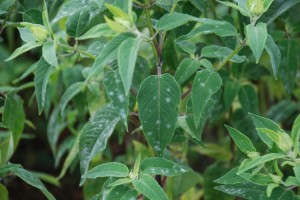Powdery mildews are serious fungal leaf diseases infecting many garden plants. Each one is host specific. The powdery mildew that attacks summer phlox does not infect zinnias or pumpkin vines. Powdery mildew disease on crape myrtles does not attack lilacs or roses. In recent years new powdery mildew diseases have popped up on dogwoods and herbaceous peonies.
Powdery mildew appears as a white floury substance on the leaf surface. Infected leaves lose much of their photosynthetic efficiency. Poor air circulation and overhead irrigation in the garden creates an ideal environment for the fungus. Fungal invasion is generally worse during prolonged cool wet spring weather or the return of cool night temperatures on late summer.
Infections on annual zinnias, summer phloxes, squashes and pumpkins generally begin in late summer or at the start of cool autumn weather. High summer humidity can really trigger a mildew outbreak and result in leaf distortions. Multi-year infestations eventually weaken and kill dogwoods, lilacs, or rose bushes.
Planting mildew resistant varieties is one of your best alternatives. However, be aware that “disease resistance” does not mean that plant(s) are “disease immuned”. Generally, mildew resistant cultivars are less susceptible and leaf injury will be less.
Other tips: Over applying nitrogen-based fertilizers may worsen an outbreak of powdery mildew. A number of fungicides prevent, but do not cure powdery mildew. Susceptible plants must be sprayed every 7-10 days. During a heavy rain fungicides are easily washed off and must be re-applied. In the fall pull up diseased plants and rake up garden debris. Remove it from the property. Do not compost diseased leaves and stems.


 Posted in
Posted in 
